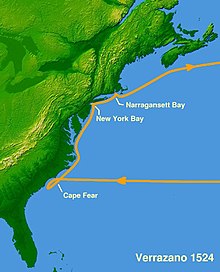Giovanni da Verrazzano
Giovanni da Verrazzano , also just called Verrazzano (* 1485 near Greve in Chianti , † 1528 in the Antilles ), was an Italian navigator and explorer.
Life
In 1485 he was born in the Castello di Verrazzano , his family's castle south of Florence in what is now the municipality of Greve in Chianti. In 1524 the French King Francis I commissioned him to look for a northern passage to Asia. On board the Dauphine, he explored some of the most famous coastal formations in North America, including New York Bay .
The Verrazzano-Narrows Bridge in New York , the Jamestown Verrazano Bridge in Jamestown (Rhode Island) and the Ponte Giovanni da Verrazzano in Florence are named after him.
Voyages of discovery
First journey
In 1524 he was sent by King Francis I of France to look for a route towards the Pacific in the region between Florida and Newfoundland . He reached the American continent on March 1st near Cape Fear , now in the state of North Carolina . From here he sailed further north, first along the Outer Banks . Here he believed that he had found a connection to the Pacific Ocean with today's Pamlico Sound . This led to the fact that for a period of about 60 years North America appeared on some maps as a two-part continent connected only by a thin land bridge , for example on a map from 1529 drawn by Girolamo da Verrazano , his brother, the "map of the western" Hemisphere "by Vesconte de Maggiolo (1527) and probably as one of the last on the map of North America drawn up in 1582 by Michael Lok , a London merchant.
During his journey he often went ashore and sought contact with Indians . Although he passed the mouth of what would later be called Chesapeake Bay , he did not explore it or note its existence. According to his records, he then sailed along the coast of what would later become New Jersey towards Lower New York Bay . He anchored in what is now known as The Narrows waterway between Long Island and Staten Island . He also discovered Upper New York Bay between Staten Island and Manhattan, as well as the Hudson River , named after Henry Hudson , who was the first European to explore it in 1609.
From New York Bay, Verrazzano sailed further along the coast of Long Island, discovering Block Island and Narragansett Bay in what is now Rhode Island . He drove on along the coast, eventually reaching Maine and also roaming the coast of Nova Scotia to return to France via Newfoundland .
More trips
Verrazzano made two more trips to America. The first took him to Brazil, among other places . On the way there , his team mutinied and tried to force him to return to France. However, due to the mutineers' lack of knowledge of navigation, he still managed to reach Brazil. From there he brought log wood with him, which brought him and his supporters a considerable profit on their return. He never returned from his third trip.
The cause of his death in 1528 is still unclear. Lawrence C. Wroth wrote that the most common assumption is that he was killed by cannibal Indians on the island of Guadeloupe , part of the Lesser Antilles , and eaten under the eyes of his crew. Against this theory speaks that , according to Alexander von Humboldt , the first discoverers brought the myth of cannibalism into the world in order to discredit the natives of the Caribbean to the Pope. This gave them permission to enslave “the savages”. According to other sources, he was captured by the Spaniards and hanged as a pirate in Cadiz .
literature
- Alberto Magnaghi: Verrazzano, Giovanni. In: Enciclopedia Italiana. (1937), ( online version )
Web links
- Giovanni da Verrazzano . In: Dictionary of Canadian Biography . 24 volumes, 1966–2018. University of Toronto Press, Toronto ( English , French ).
- Giovanni da Verrazzano at greve-in-chianti.com (German)
Individual evidence
- ^ Lawrence C. Wroth: The Voyages of Giovanni da Verrazzano, 1524-1528. Yale University Press, New Haven 1970, ISBN 0-300-01207-1 , p. 210.
- ↑ Alexander von Humboldt: Journey to the equinoctial areas of the new continent in the years 1799, 1800, 1801, 1802, 1803 and 1804.
- ^ Henry Cruse Murphy: The Voyage of Verrazzano: A Chapter in the Early History of Maritime Discovery in America. Press of J. Munsell, New York 1875, p. 149.
| personal data | |
|---|---|
| SURNAME | Verrazzano, Giovanni there |
| ALTERNATIVE NAMES | Verrazano, Giovanni there |
| BRIEF DESCRIPTION | Italian navigator and explorer |
| DATE OF BIRTH | 1485 |
| PLACE OF BIRTH | at Greve in Chianti |
| DATE OF DEATH | 1528 |
| Place of death | Antilles |

